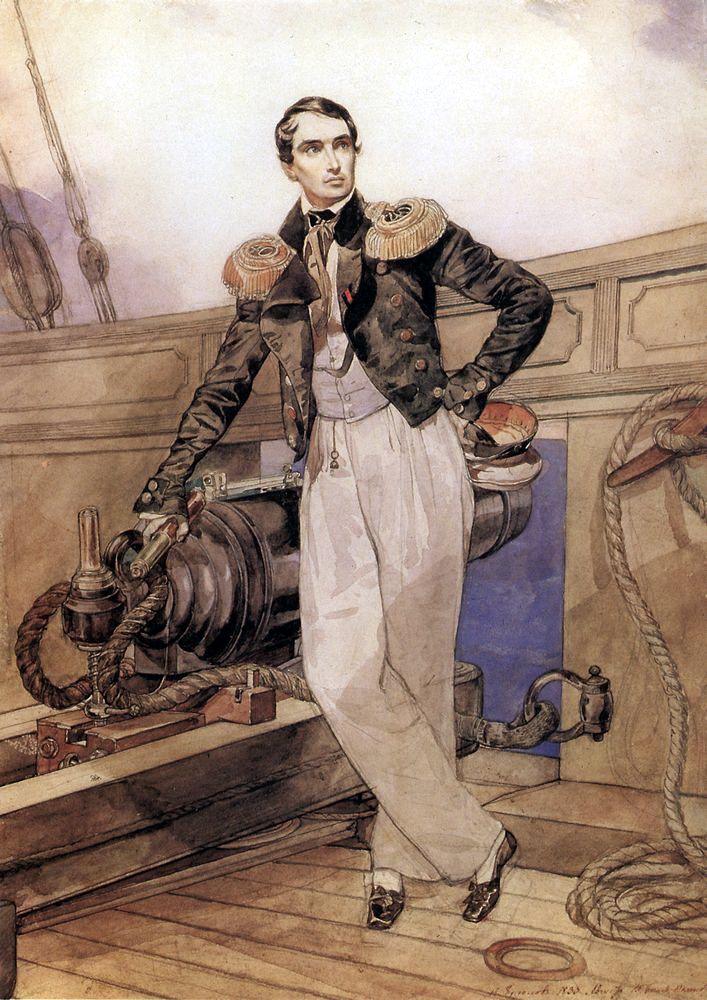|
Vladimir Alexeyevich Kornilov
Vice Admiral Vladimir Alexeyevich Kornilov (; 13 February 1806 – 17 October 1854) was a Russian naval officer who took part in the Crimean War and is known for his battle against the Pervaz-ı Bahrî in what is considered the first battle between steam ships. Biography Early Life and Career Kornilov was born on his family estate in Staritsky District, Tver Governorate in 1806. His father was governor of Irkutsk. Kornilov entered the naval service in 1823, and in 1827 he fought in the Battle of Navarino as a midshipman aboard the fleet's flagship . In 1841 he became the first captain of the battleship ''Twelve Apostles'', he disciplined the crew and participated with it in the Black Sea Fleet Review (held every seven years) before Grand Duke Konstantin Nikolayevich. He sailed to London in 1847 to buy a new steam frigate. In 1849 he became chief of staff Black Sea Fleet. Crimean War Battle against the ''Pervaz-ı Bahrî'' The Russian Black Fleet was spli ... [...More Info...] [...Related Items...] OR: [Wikipedia] [Google] [Baidu] |
Staritsky District
Staritsky District (russian: Ста́рицкий райо́н) is an administrative and municipalLaw #4-ZO district (raion), one of the administrative divisions of Tver Oblast, thirty-six in Tver Oblast, Russia. It is located in the central and southern parts of the oblast and borders with Kuvshinovsky District in the north, Torzhoksky District in the northeast, Kalininsky District, Tver Oblast, Kalininsky District in the east, Lotoshinsky District of Moscow Oblast in the southeast, Zubtsovsky District in the south, Rzhevsky District in the southwest, and with Selizharovsky District in the west. The area of the district is . Its administrative center is the types of inhabited localities in Russia, town of Staritsa (town), Tver Oblast, Staritsa. Population: 24,056 (Russian Census (2010), 2010 Census); The population of Staritsa accounts for 35.8% of the district's total population. Geography The whole area of the district belongs to the drainage basin of the Volga River. The Vol ... [...More Info...] [...Related Items...] OR: [Wikipedia] [Google] [Baidu] |
Grand Duke Konstantin Nikolayevich Of Russia
Grand Duke Konstantin Nikolayevich of Russia (21 September 1827 – 25 January 1892) was the Emperor's Viceroy of Poland from 1862 to 1863. Early life Konstantin Nikolayevich was born as the second son of Nicholas I and his wife, Charlotte of Prussia, daughter of Frederick William III of Prussia and his first wife, Louise of Mecklenburg-Strelitz. Biography The Grand Duke was a supporter of the liberal (sometimes referred to as "enlightened") bureaucrats during the period of his brother Alexander II's great reforms. He served as chairman of the Imperial Russian Geographical Society (founded in 1845). The Geographical Society was subordinate to the Ministry of Internal Affairs, which was home to a conspicuous number of , including Nikolai Miliutin. In addition to his support of and participation in the 1861 emancipation of the serfs, the Grand Duke also instituted reforms in the Imperial Russian Navy from 1854. Konstantin's brother, Alexander II of Russia was supposed ... [...More Info...] [...Related Items...] OR: [Wikipedia] [Google] [Baidu] |
Mikhail Lazarev
Admiral Mikhail Petrovich Lazarev (russian: Михаил Петрович Лазарев, 3 November 1788 – 11 April 1851) was a Russian fleet commander and an explorer. Education and early career Lazarev was born in Vladimir, a scion of the old Russian nobility from the Vladimir province. In 1800, he enrolled in Russia's Naval College. Three years later he was sent to the British Royal Navy, where he would stay for a continuous five-year navigation. From 1808 to 1813, Lazarev served in the Baltic Fleet. He took part in the Russo-Swedish War of 1808–1809 and Patriotic War of 1812. Career as an explorer Lazarev first circumnavigated the globe in 1813–1816, aboard the vessel ''Suvorov''; the expedition began at Kronstadt and reached Alaska. During this voyage, Lazarev discovered the Suvorov Atoll. As a commander of the ship and Fabian Gottlieb von Bellingshausen's deputy on his world cruise in 1819–1821 (Bellingshausen commanded ), Lazarev took part in the discovery o ... [...More Info...] [...Related Items...] OR: [Wikipedia] [Google] [Baidu] |
Vladimir Istomin
Vladimir (Vladislav) Ivanovich Istomin (russian: Владимир (Владислав) Иванович Истомин; – ) was a Russian rear admiral (1853) and hero of the Siege of Sevastopol. Biography In 1827, Vladimir Istomin graduated from the Naval College. That same year, he then took part in the Battle of Navarino and later in the blockade of the Dardanelles (1828-1829). In 1836, Istomin was transferred from the Baltic Fleet to the Black Sea Fleet. In 1850, he was appointed commander of the ship of the line ''Parizh'' (Париж), which would participate in the Battle of Sinop in 1853. During the Siege of Sevastopol, Vladimir Istomin was in charge of the defense of the Malakhov Mound (Малахов курган) and nearby redoubt A redoubt (historically redout) is a fort or fort system usually consisting of an enclosed defensive emplacement outside a larger fort, usually relying on earthworks, although some are constructed of stone or brick. It is meant ... [...More Info...] [...Related Items...] OR: [Wikipedia] [Google] [Baidu] |
Vladimir Vs Pervaz-i Bahri
Vladimir may refer to: Names * Vladimir (name) for the Bulgarian, Croatian, Czech, Macedonian, Romanian, Russian, Serbian, Slovak and Slovenian spellings of a Slavic name * Uladzimir for the Belarusian version of the name * Volodymyr for the Ukrainian version of the name * Włodzimierz (given name) for the Polish version of the name * Valdemar for the Germanic version of the name * Wladimir for an alternative spelling of the name Places * Vladimir, Russia, a city in Russia * Vladimir Oblast, a federal subject of Russia * Vladimir-Suzdal, a medieval principality * Vladimir, Ulcinj, a village in Ulcinj Municipality, Montenegro * Vladimir, Gorj, a commune in Gorj County, Romania * Vladimir, a village in Goiești Commune, Dolj County, Romania * Vladimir (river), a tributary of the Gilort in Gorj County, Romania * Volodymyr (city), a city in Ukraine Religious leaders * Metropolitan Vladimir (other), multiple * Jovan Vladimir (d. 1016), ruler of Doclea and a saint of the Serb ... [...More Info...] [...Related Items...] OR: [Wikipedia] [Google] [Baidu] |
Istanbul
Istanbul ( , ; tr, İstanbul ), formerly known as Constantinople ( grc-gre, Κωνσταντινούπολις; la, Constantinopolis), is the List of largest cities and towns in Turkey, largest city in Turkey, serving as the country's economic, cultural and historic hub. The city straddles the Bosporus strait, lying in both Europe and Asia, and has a population of over 15 million residents, comprising 19% of the population of Turkey. Istanbul is the list of European cities by population within city limits, most populous European city, and the world's List of largest cities, 15th-largest city. The city was founded as Byzantium ( grc-gre, Βυζάντιον, ) in the 7th century BCE by Ancient Greece, Greek settlers from Megara. In 330 CE, the Roman emperor Constantine the Great made it his imperial capital, renaming it first as New Rome ( grc-gre, Νέα Ῥώμη, ; la, Nova Roma) and then as Constantinople () after himself. The city grew in size and influence, eventually becom ... [...More Info...] [...Related Items...] OR: [Wikipedia] [Google] [Baidu] |
Ottoman Frigate Taif
''Taif'' was one of four wooden-hulled paddle frigates built for the Ottoman Navy in the 1840s; they were the first Ottoman-built warships powered by steam. She served with the fleet until 1867, including during the Crimean War, where she saw a minor battle with a Russian frigate in the Black Sea. She was present at the Battle of Sinop, but her steam engine allowed her to escape before the Russian fleet destroyed the Ottoman squadron in the port. The ship remained in service until 1867, seeing little activity during this period, and was ultimately broken up in 1868. Design ''Taif'' was a paddle frigate. She was long overall, with a beam of and a draft of . Her tonnage was 1,443 tons burthen. She was propelled by a pair of paddlewheels that were driven by a direct-acting steam engine, with steam provided by two coal-fired boilers. Her propulsion system was rated at for a top speed of . Her coal storage capacity amounted to . She had a crew of 320. The ship was armed with a ... [...More Info...] [...Related Items...] OR: [Wikipedia] [Google] [Baidu] |
Ship Commissioning
Ship commissioning is the act or ceremony of placing a ship in active service and may be regarded as a particular application of the general concepts and practices of project commissioning. The term is most commonly applied to placing a warship in active duty with its country's military forces. The ceremonies involved are often rooted in centuries-old naval tradition. Ship naming and launching endow a ship hull with her identity, but many milestones remain before she is completed and considered ready to be designated a commissioned ship. The engineering plant, weapon and electronic systems, galley, and other equipment required to transform the new hull into an operating and habitable warship are installed and tested. The prospective commanding officer, ship's officers, the petty officers, and seamen who will form the crew report for training and familiarization with their new ship. Before commissioning, the new ship undergoes sea trials to identify any deficiencies needing c ... [...More Info...] [...Related Items...] OR: [Wikipedia] [Google] [Baidu] |
Steam Frigate
Steam frigates (including screw frigates) and the smaller steam corvettes, steam sloops, steam gunboats and steam schooners, were steam-powered warships that were not meant to stand in the line of battle. There were some exceptions like for example the French Napoléon class steam ship of the line was meant to stand in the line of battle, making it the world's first steam battleship. The first such ships were paddle steamers. Later on the invention of screw propulsion enabled construction of steam-powered versions of the traditional ships of the line, frigates, corvettes, sloops and gunboats. Evolution First steam warships The first small vessel that can be considered a steam warship was the '' Demologos'', which was launched in 1815 for the United States Navy. From the early 1820s, the British Navy began building a number of small steam warships including the armed tugs and , and by the 1830s the navies of America, Russia and France were experimenting with steam-pow ... [...More Info...] [...Related Items...] OR: [Wikipedia] [Google] [Baidu] |
Alexander Sergeyevich Menshikov
Prince Alexander Sergeyevich Menshikov (russian: Князь Алекса́ндр Серге́евич Ме́ншиков; 26 August 17872 May 1869) was a Russian nobleman, military commander and statesman. He was made adjutant general in 1817 and admiral in 1833. A great-grandson of Alexander Danilovich Menshikov, Duke of Ingria, and a cognatic descendant of the Princely House of Golitsyn (another of his great-grandfathers was Prince Mikhail Golitsyn, the military governor of Åbo during the Russian occupation in the Great Northern War). Menshikov entered the Russian service as attaché to the embassy at Vienna in 1809. He became close to Tsar Alexander I and accompanied him throughout his campaigns against Napoleon. In 1817 Menshikov was appointed acting Quartermaster general of the General Staff. In 1823, he was transferred to the ministry of foreign affairs. Menshikov retired from army service in 1824. During the initiation of the Russo-Persian War of 1826–28 and the ... [...More Info...] [...Related Items...] OR: [Wikipedia] [Google] [Baidu] |


_underway_2009.jpg)